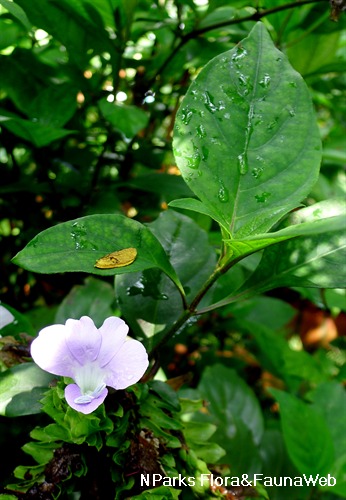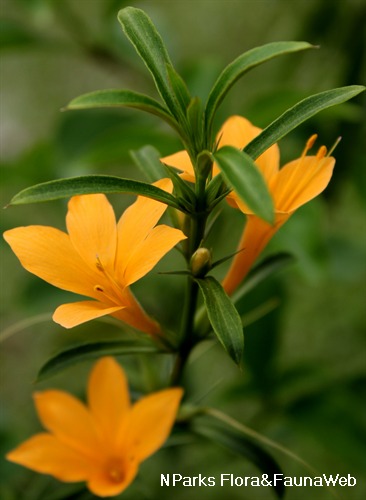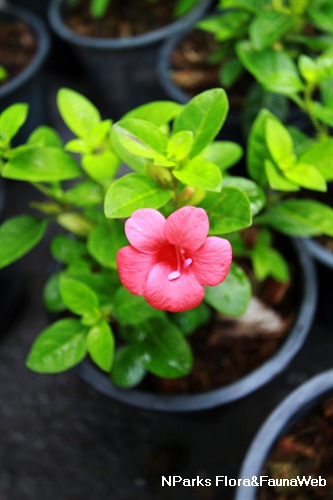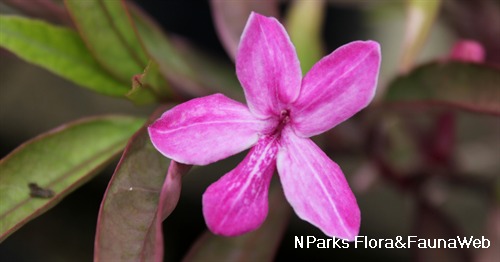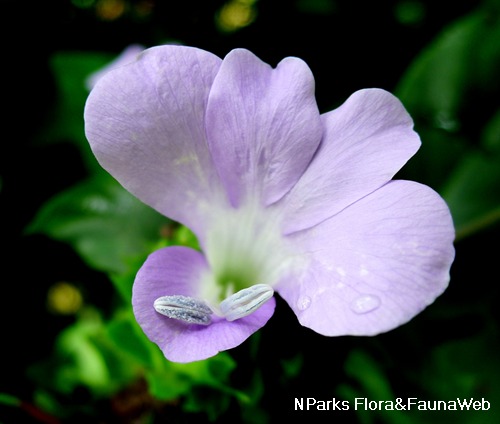
Back
Barleria strigosa Willdenow
| Family Name: | Acanthaceae |
| Synonyms: | Barleria purpureosepala H.P.Tsui. |
| Common Name: | Barleria, 紫萼假杜鹃 |
Name
Classifications and Characteristics
| Plant Division | Angiosperms (Flowering Seed Plants) |
|---|---|
| Plant Growth Form | Shrub |
| Lifespan (in Singapore) | Perennial |
| Mode of Nutrition | Autotrophic |
Biogeography
| Native Distribution | India, Sri Lanka, southern China, Nepal, Bhutan, Myanmar, Thailand, Cambodia, Vietnam, Malaysia, Indonesia. |
|---|---|
| Native Habitat | Terrestrial (Primary Rainforest) |
| Preferred Climate Zone | Tropical, Sub-Tropical / Monsoonal |
| Local Conservation Status | Non-native (Horticultural / Cultivated Only) |
Description and Ethnobotany
| Growth Form | It is a upright shrub, growing up to 0.8 m tall. |
|---|---|
| Foliage | Its opposite, stalked leaves are elliptic to ovate, covered with fine hairs and are 5.5-15 cm by 2.2-5.5 cm. |
| Flowers | Its purplish flowers are 5-6 cm long, borne on dense terminal disc-shaped cymes. |
| Fruit | Its fruits are ellipsoid capsules that are 1.4-1.8 cm by 0.5 cm. |
| Habitat | It grows in forests. |
| Associated Fauna | Its flowers are probably insect pollinated. |
| Cultivation | It can be propagated by seed. |
| Etymology | Latin Barleria, after Reverend J. Barlier (Barrelier) (d. 1673), a French botanist. Latin strigosa, strigose, referring to the fine hairs that cover almost all parts of the plant. |
Landscaping Features
| Desirable Plant Features | Ornamental Flowers |
|---|---|
| Landscape Uses | Small Gardens, Flowerbed / Border |
Fauna, Pollination and Dispersal
| Pollination Method(s) | Biotic (Fauna) |
|---|---|
| Seed or Spore Dispersal | Abiotic |
Plant Care and Propagation
| Light Preference | Full Sun, Semi-Shade |
|---|---|
| Water Preference | Moderate Water |
| Rootzone Tolerance | Moist Soils, Well-Drained Soils, Fertile Loamy Soils |
| Propagation Method | Seed |
Foliar
| Foliage Retention | Evergreen |
|---|---|
| Mature Foliage Colour(s) | Green |
| Mature Foliage Texture(s) | Velvety / Furry / Tomentose |
| Foliar Type | Simple / Unifoliate |
| Foliar Arrangement Along Stem | Opposite |
| Foliar Attachment to Stem | Petiolate |
| Foliar Shape(s) | Non-Palm Foliage (Lanceolate, Elliptical) |
| Foliar Venation | Pinnate / Net |
| Foliar Margin | Entire |
Floral (Angiosperm)
| Flower & Plant Sexuality | Bisexual Flowers |
| Flower Colour(s) | Blue |
|---|---|
| Flower Grouping | Cluster / Inflorescence |
| Flower Location | Terminal |
| Individual Flower Shape | Funnelform / Funnel-shaped |
| Inflorescence Type | Cyme |
Fruit, Seed and Spore
| Mature Fruit Colour(s) | Brown |
|---|---|
| Fruit Classification | Simple Fruit |
| Fruit Type | Dehiscent Dry Fruit , Capsule |
Image Repository
Others
| Master ID | 31258 |
|---|---|
| Species ID | 5653 |
| Flora Disclaimer | The information in this website has been compiled from reliable sources, such as reference works on medicinal plants. It is not a substitute for medical advice or treatment and NParks does not purport to provide any medical advice. Readers should always consult his/her physician before using or consuming a plant for medicinal purposes. |

